An exhibit of handwoven tapestries in Samarina
By Maria Psomiades
During my visit to Samarina village in Greece last summer, I visited a fascinating exhibit with hand-woven tapestries. They were temporarily lent for the exhibit by the residents, who preserve them and pass them from one generation to another. Although I was familiar with the art of weaving, I was blown away by the elaborate designs, intricate geometric patterns, and vibrant colors.
The tapestries were woven with a loom, a wooden hand-operated machine. In the old days, almost every household had a loom and the girls used it to weave their dowries. The women made the yarn from sheep’s’ wool with a spinning wheel and spindle and dyed it with natural colors.
Ms. Haido Agorogianni-Voutsa, the curator of the exhibit, explained that the red background color of these woven tapestries originated from the root of the plant “rizari”, which produces a red pigment suitable for dyeing yarn. Rizari is a native shrub that grows in Southern Europe and its official name is red ruby or dyers broom (rubia tinctorum). All the colors were made from plants. Brown was made from walnut shells and walnut leaves, yellow from dried mulberry leaves, blue from flowers. One of the themes, maybe the most philosophical, is the tree of life. The tapestry from 1895 illustrates in its center the tree of life which, according to a philosophy of religions, symbolizes the three worlds, the subterranean, the physical world, and a spiritual realm.
These woven tapestries were used as curtains, called berdes (μπερντες). Others were hung on the wall, cover the beds or used as mats (kilimia). They decorated the households, evoking a sense of warmth, and a cozy and inviting feeling. The women in Samarina and other Vlach villages in the area were able to develop a unique technique and style to display their creativity and shared their weaving tradition with their community.
I could not help thinking with pride that I also own a kilimi, from my father’s dowry, who was from the nearby village Perivoli. Although it is more than 100 years old, the colors of the flowers are vivid with rich hues. Visiting this exhibit and learning so much about the way these woven tapestries were made, made me further appreciate my heritage and the creative art of weaving.



Responses